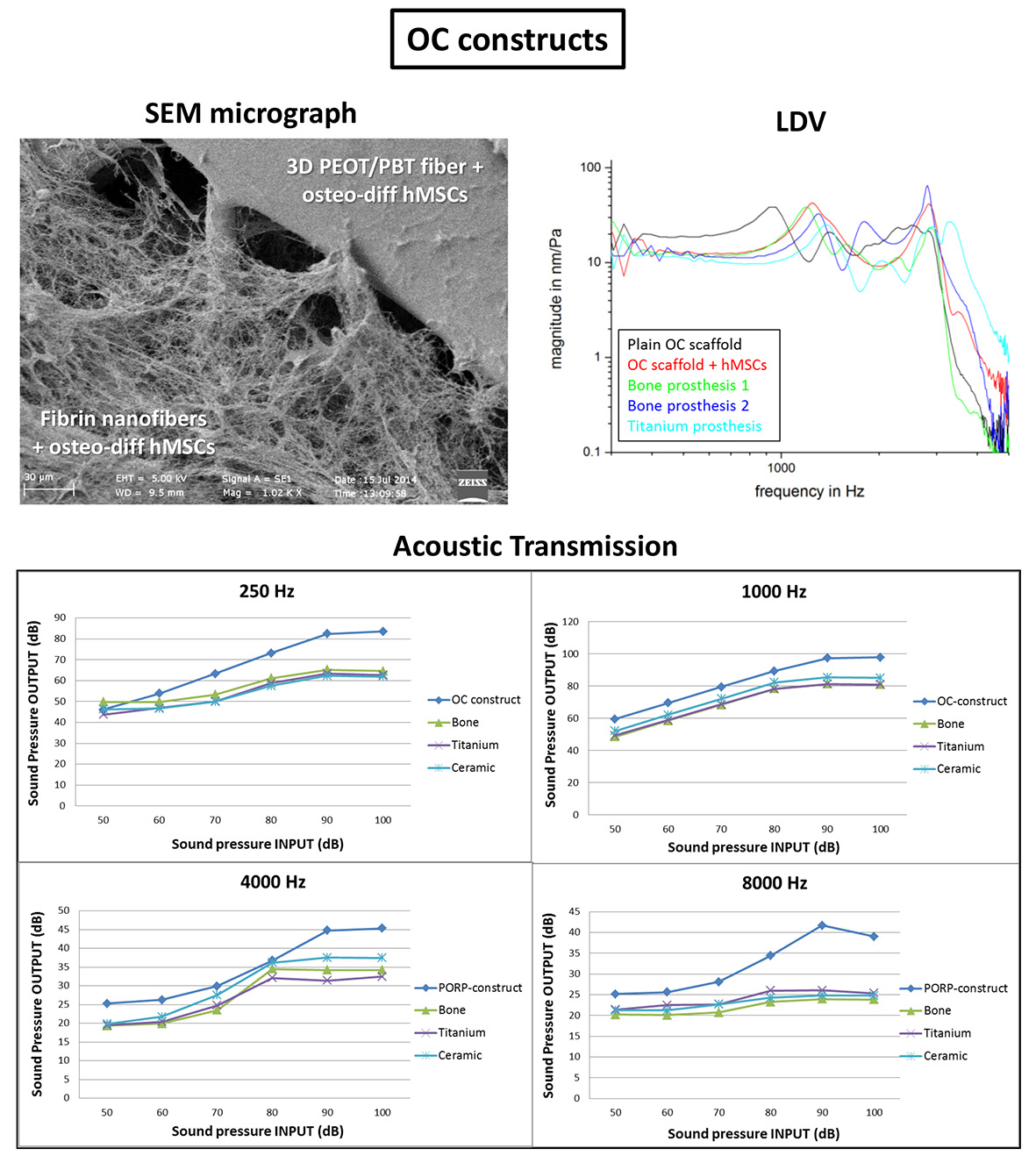Engineering advanced middle ear tissues: where biomimicry of vibrating surfaces connects to optimal organ function
Serena
Danti1, 2*,
Thomas
Stoppe3*,
Carlos
Mota4*,
Luisa
Trombi1,
Mario
Milazzo2,
Andrea
De Vito1*,
Rodney
J.
Dilley5*,
Cesare
Stefanini2*,
Marcus
Neudert3*,
Lorenzo
Moroni4* and
Stefano
Berrettini1
-
1
University of Pisa, OtoLab, Departmentof Surgical, Medical, Molecular Pathology and Emergency Medicine, Italy
-
2
Scuola Superiore Sant'Anna, Laboratory of Creative Engineering & Design, the Biorobotics Institute, Italy
-
3
Carl Gustav Carus University, Otorhinolaryngology Head & Neck Surgery Clinic, Germany
-
4
Maastricht University, MERLN, Complex Tissue Regeneration Department, Netherlands
-
5
University of Western Australia, Ear Science Institute Australia & Ear Sciences Centre, School of Surgery, Australia
Introduction: Hearing function occurs via vibrations, namely, via collection and transmission of sound waves. The anatomy of ear tissues is perfectly tuned from nano-to-macro scale, so as to accomplish a fine hearing. Ear pathologies pose challenging applications for micro-prosthetics in which biomaterial surfaces and biomaterial/tissue interfaces play key roles for device performance and integration. This study is aimed at developing biomimetic tissue-engineered substitutes, using fabrication techniques acting at different scale levels to overcome the drawbacks of current prostheses, such as extrusion or suboptimal performance.
Materials and Methods: Poly(ethylene oxide terephthalate)/poly(butylene terephthalate) (PEOT/PBT) copolymer scaffolds for ossicular chain (OC) and tympanic membrane (TM) were produced via different biofabrication techniques. TM scaffolds were obtained combining electrospinning with additive manufacturing, thus leading to single, dual and triple scale PEOT/PBT structures, with surface cues emulating the orientation of native TM collagen fibers, either radiate or circular[1]. OC scaffolds were produced via 3D fiber deposition combined with fibrin hydrogel. The OC and TM scaffolds were cultured with human mesenchymal stromal cells (hMSCs) under appropriate differentiation stimuli (osteogenic or regular growth media). Human TM keratinocytes (hTMKs) were used to check epithelial cell interaction. Use of human cells for research was approved by Ethics boards of local hospitals. Vibration patterns of plain and cellularized scaffolds was assessed via Laser Doppler Vibrometry (LDV), on anatomic models. Direct acoustic transmission measurements in the hearing frequency range (250-8.000 Hz) were performed using a patented test apparatus.
Results and Discussion: PEOT/PBT OC scaffolds showed a supportive macrostructure with fiber diameter of 152±14 μm and a filling matrix of fibrin (fiber diameter 100 nm). In 1×1 μm2 microfiber areas, roughness Ra was 14.0±6.0 and Rq was 18.1±7.8. After 27 osteodifferentiation days, the obtained OC constructs showed good cellularity (2.55±0.48 μg/sample), intense osteogenic antigen expression, dense calcium matrix and high total calcium content (0.56±0.12 g Ca2+/sample). Measured acoustic transmission of OC constructs was superior to those of commercial prostheses in titanium, compact bone and hydroxyapatite, with best performance (10-15 dB gain) both at low and high frequencies (Figure 1). Cellular material shifted the resonance frequency of plain scaffolds towards those of devices usually implanted. Multiscale PEOT/PBT TM scaffolds were produced as electrospun mats (mesh thickness 95±15 μm, fiber diameter 2.0±0.6 μm) either plain, or with applied circular/radiate grid/s on its side/s (grid fiber diameter 352±32 μm). On TM scaffolds, hMSCs were viable after 10 days and hTMKs adhered in 48 hr (Figure 2). Addition of hMSCs to single scale TM scaffolds made it vibration close to that of native TM. The presence of grids caused vibration damping.


Conclusion: When looking for biomimicry of middle ear devices, several parameters such as mass, shape, elasticity, composition, micro and nanostructures must be balanced to achieve optimal performance under vibratory constrains.
Tuscany Region - Health Program 2009; MIUR (PRIN 2010S58B38)
References:
[1] Mota C, Danti S, D’Alessandro D, Trombi L, Ricci C, Puppi D, Dinucci D, Milazzo M, Stefanini C, Chiellini F, Moroni L Berrettini S. Multiscale fabrication of biomimetic scaffolds for tympanic membrane tissue engineering. Biofabrication 2015, 7(2):025005.
Keywords:
Regenerative Medicine,
Biomimetic,
material design,
ENT
Conference:
10th World Biomaterials Congress, Montréal, Canada, 17 May - 22 May, 2016.
Presentation Type:
Poster
Topic:
Biomimetic materials
Citation:
Danti
S,
Stoppe
T,
Mota
C,
Trombi
L,
Milazzo
M,
De Vito
A,
Dilley
RJ,
Stefanini
C,
Neudert
M,
Moroni
L and
Berrettini
S
(2016). Engineering advanced middle ear tissues: where biomimicry of vibrating surfaces connects to optimal organ function.
Front. Bioeng. Biotechnol.
Conference Abstract:
10th World Biomaterials Congress.
doi: 10.3389/conf.FBIOE.2016.01.01977
Copyright:
The abstracts in this collection have not been subject to any Frontiers peer review or checks, and are not endorsed by Frontiers.
They are made available through the Frontiers publishing platform as a service to conference organizers and presenters.
The copyright in the individual abstracts is owned by the author of each abstract or his/her employer unless otherwise stated.
Each abstract, as well as the collection of abstracts, are published under a Creative Commons CC-BY 4.0 (attribution) licence (https://creativecommons.org/licenses/by/4.0/) and may thus be reproduced, translated, adapted and be the subject of derivative works provided the authors and Frontiers are attributed.
For Frontiers’ terms and conditions please see https://www.frontiersin.org/legal/terms-and-conditions.
Received:
27 Mar 2016;
Published Online:
30 Mar 2016.
*
Correspondence:
Dr. Serena Danti, University of Pisa, OtoLab, Departmentof Surgical, Medical, Molecular Pathology and Emergency Medicine, Pisa, Italy, Email1
Dr. Thomas Stoppe, Carl Gustav Carus University, Otorhinolaryngology Head & Neck Surgery Clinic, Dresden, Germany, Thomas.Stoppe@uniklinikum-dresden.de
Dr. Carlos Mota, Maastricht University, MERLN, Complex Tissue Regeneration Department, Maastricht, Netherlands, c.mota@maastrichtuniversity.nl
Dr. Andrea De Vito, University of Pisa, OtoLab, Departmentof Surgical, Medical, Molecular Pathology and Emergency Medicine, Pisa, Italy, advvito@gmail.com
Dr. Rodney J Dilley, University of Western Australia, Ear Science Institute Australia & Ear Sciences Centre, School of Surgery, Nedlands, Australia, rodney.dilley@esia.org.au
Dr. Cesare Stefanini, Scuola Superiore Sant'Anna, Laboratory of Creative Engineering & Design, the Biorobotics Institute, Pontedera, Italy, cesare.stefanini@sssup.it
Dr. Marcus Neudert, Carl Gustav Carus University, Otorhinolaryngology Head & Neck Surgery Clinic, Dresden, Germany, Marcus.Neudert@uniklinikum-dresden.de
Dr. Lorenzo Moroni, Maastricht University, MERLN, Complex Tissue Regeneration Department, Maastricht, Netherlands, l.moroni@maastrichtuniversity.nl